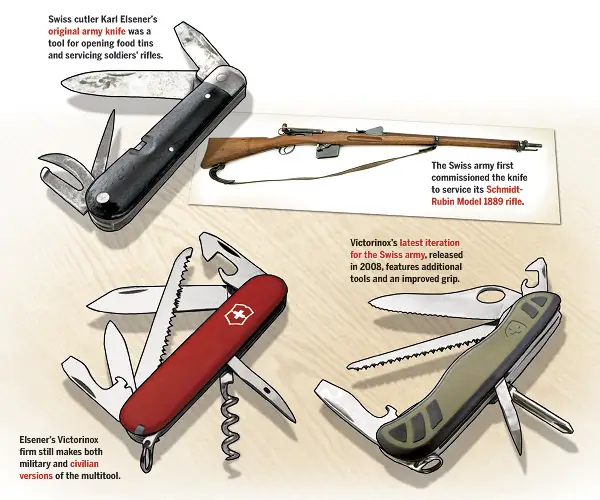When you hear the name Victorinox, you automatically think of the red and white cross they’re famous for. Behind this cross is a lot of effort, years, and dedication. The company didn’t rise to be on top of the world easily. There’s a long journey behind it.
Here, we’ll dive into the detailed history of Victorinox, and we’ll give you a sneak peek into their products and the materials they use.
But before that, you may read our review article on the best swiss army knife. Don’t buy any knife before reading the article!
Starting From Day One – The Juicy Details
Victorinox didn’t evolve to become the brand it is in a couple of nights. It took decades of ambitious effort to get them where they are. Let’s delve into the details of their history.
The Evolution of Victorinox
The tale began in 1884 when Karl Elsener I pursued a career in cutlery. He opened a knife workshop in Ibach-Schwyz, Switzerland, and success was his sidekick for the first few years. Merely 7 years later, he established the Association of Swiss Master Cutlers, which enabled him to deliver soldiers’ knives to the Swiss army.
In 1909, Karl registered the company’s emblem that we know of today. He chose the name ‘Victoria’ in memory of his late mother. It stayed that way until 1921 when stainless steel was invented under the name of inox. The name then merged to include the revolutionary material of the cutlery industry, which resulted in today’s brand name – Victorinox.
Nearly 7 decades later, the cutlery company expanded to include watches in its wide array of products. Shortly after, travel gear also joined the association. As of 2011, the company started issuing all of its products under a unified name: Victorinox Swiss Army. And it stands until today.
Significant Milestones in Victorinox’ History
The evolution couldn’t have happened without a number of milestones over the years. Here’s a quick review of each milestone.
1884 – Ready, Set, Go!
The biggest milestone of them all. 1884 was the year Karl Elsener I decided to go into the cutlery business. He opened his first workshop in Ibach-Schwyz.
1989 – Hello, Watches.
1989 was the year Victorinox started manufacturing watches and selling it in the United States under the name Swiss Army. And the rest is history!
1994 – A New Foundation
In 1994, the current CEO at the time, Carl Elsener, started a foundation with Elise Elsener. The foundation aimed at supporting charitable projects. At the moment, it owns 10% of the company.
1999 – Introduction of Travel Gear
In 1999, TRG started making luggage for the Swiss Army, licensed by Victorinox. This was the start of Victorinox’s journey in manufacturing travel gear. (Don’t forget to add these hiking knives on your travel gear list)
In 2014, Victorinox purchased TRG and gained full acquisition of its products.
2013 – Here Comes Wegner
7 years ago, Wegner integrated with Victorinox. Since then, it’s been manufacturing its products under the foundation’s name.
Victorinox as the Brand it is Today
Today, Victorinox is boasting 136 years of existence in the cutlery market. Let’s see what a brand can do in nearly a century and a half.
Products & Materials
Victorinox is now known for its five product categories: swiss army knives, cutlery, watches, fragrances, and travel gear. Although stainless steel was its starting point, its products’ materials now go beyond that.
For starters, the manufacturers use Damascus steel for their Damast knives. The material is known for its extraordinary strength, thanks to its carbon structure. It also has a distinct pattern that’s similar to water waves, which gives the knives a touch of elegance.
For the knife scales, they use Alox, which is the key feature in their sought-after foldable pocket knives. The material is called Alox because the aluminum goes through a process called Eloxal. This process adds a protective coating to the aluminum by anodic oxidation, which adds its functionality and durability.
As for the watches, they use a carbon composite that can endure hot temperatures up to 1200 ºC. That’s not its only advantage, the material is also lightweight and scratch-resistant. Not to mention that its black color makes a bold fashion statement.
Customer Satisfaction
Naturally, a company in Victorinox’s size prioritizes customer satisfaction. They have a lot of ways to show it. Firstly, there’s a product support section for each product category. You can select any category you want and you’ll find answers to all your questions.
Secondly, they offer lifetime warranties for their knives and pocket knives. You also get 5 years for watches, 11 years for travel gear, and free return for defective fragrances.
It doesn’t stop here. There are local subsidiaries in 16 countries around the world, in case you need help with anything. The subsidiaries are scattered around Europe, Asia, and the Americas.
What Makes Victorinox the Best?
Victorinox put a lot of dedication and effort into their products, be it knives, or watches, or something else. The company is on top of the list of knife makers around the globe, and it’s not out of nowhere. They integrate Swiss precision with high functionality to manufacture something customers can speak of.
All that being said, Victorinox’s products aren’t expensive. They’re issued at moderate prices, and they give great value in return. Additionally, the company cares immensely for customer satisfaction. Up to the point where you get a lifetime warranty for any knife you buy there. What more could a customer want?
Closing Thoughts
You can’t lose with Victorinox. Any product of theirs you choose to get will exceed your expectations; in terms of quality, functionality, and price. It took them more than 13 decades to get there, and the products are worth the journey.

